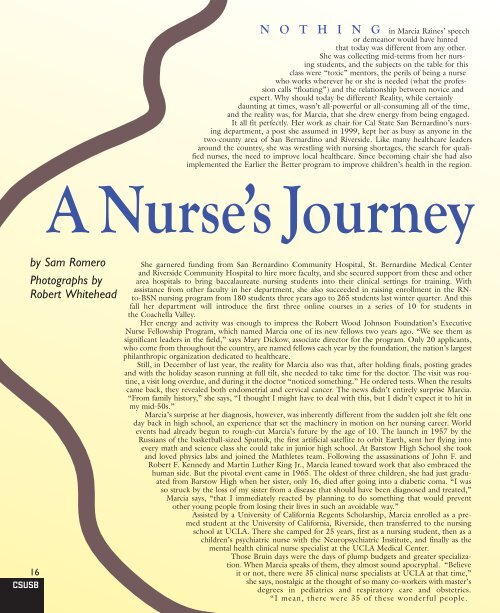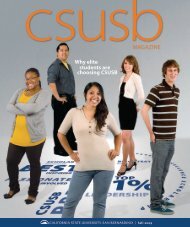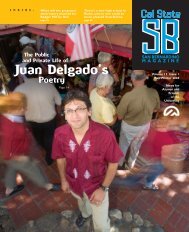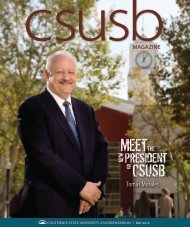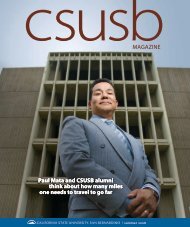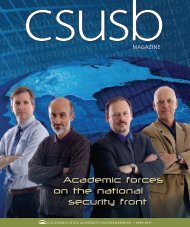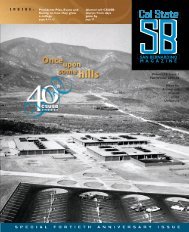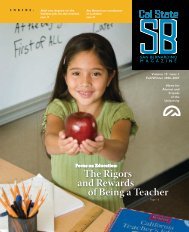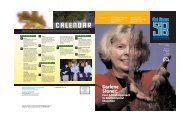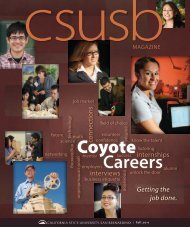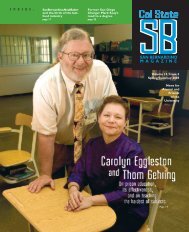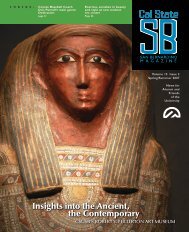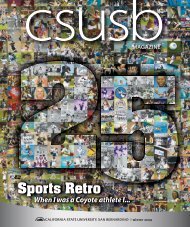The Road is Never Straight - CSUSB Magazine - California State ...
The Road is Never Straight - CSUSB Magazine - California State ...
The Road is Never Straight - CSUSB Magazine - California State ...
You also want an ePaper? Increase the reach of your titles
YUMPU automatically turns print PDFs into web optimized ePapers that Google loves.
N O T H I N G<br />
in Marcia Raines’ speech<br />
or demeanor would have hinted<br />
that today was different from any other.<br />
She was collecting mid-terms from her nursing<br />
students, and the subjects on the table for th<strong>is</strong><br />
class were “toxic” mentors, the perils of being a nurse<br />
who works wherever he or she <strong>is</strong> needed (what the profession<br />
calls “floating”) and the relationship between novice and<br />
expert. Why should today be different? Reality, while certainly<br />
daunting at times, wasn’t all-powerful or all-consuming all of the time,<br />
and the reality was, for Marcia, that she drew energy from being engaged.<br />
It all fit perfectly. Her work as chair for Cal <strong>State</strong> San Bernardino’s nursing<br />
department, a post she assumed in 1999, kept her as busy as anyone in the<br />
two-county area of San Bernardino and Riverside. Like many healthcare leaders<br />
around the country, she was wrestling with nursing shortages, the search for qualified<br />
nurses, the need to improve local healthcare. Since becoming chair she had also<br />
implemented the Earlier the Better program to improve children’s health in the region.<br />
A Nurse’s Journey<br />
16<br />
<strong>CSUSB</strong><br />
by Sam Romero<br />
Photographs by<br />
Robert Whitehead<br />
She garnered funding from San Bernardino Community Hospital, St. Bernardine Medical Center<br />
and Riverside Community Hospital to hire more faculty, and she secured support from these and other<br />
area hospitals to bring baccalaureate nursing students into their clinical settings for training. With<br />
ass<strong>is</strong>tance from other faculty in her department, she also succeeded in ra<strong>is</strong>ing enrollment in the RNto-BSN<br />
nursing program from 180 students three years ago to 265 students last winter quarter. And th<strong>is</strong><br />
fall her department will introduce the first three online courses in a series of 10 for students in<br />
the Coachella Valley.<br />
Her energy and activity was enough to impress the Robert Wood Johnson Foundation’s Executive<br />
Nurse Fellowship Program, which named Marcia one of its new fellows two years ago. “We see them as<br />
significant leaders in the field,” says Mary Dickow, associate director for the program. Only 20 applicants,<br />
who come from throughout the country, are named fellows each year by the foundation, the nation’s largest<br />
philanthropic organization dedicated to healthcare.<br />
Still, in December of last year, the reality for Marcia also was that, after holding finals, posting grades<br />
and with the holiday season running at full tilt, she needed to take time for the doctor. <strong>The</strong> v<strong>is</strong>it was routine,<br />
a v<strong>is</strong>it long overdue, and during it the doctor “noticed something.” He ordered tests. When the results<br />
came back, they revealed both endometrial and cervical cancer. <strong>The</strong> news didn’t entirely surpr<strong>is</strong>e Marcia.<br />
“From family h<strong>is</strong>tory,” she says, “I thought I might have to deal with th<strong>is</strong>, but I didn’t expect it to hit in<br />
my mid-50s.”<br />
Marcia’s surpr<strong>is</strong>e at her diagnos<strong>is</strong>, however, was inherently different from the sudden jolt she felt one<br />
day back in high school, an experience that set the machinery in motion on her nursing career. World<br />
events had already begun to rough-cut Marcia’s future by the age of 10. <strong>The</strong> launch in 1957 by the<br />
Russians of the basketball-sized Sputnik, the first artificial satellite to orbit Earth, sent her flying into<br />
every math and science class she could take in junior high school. At Barstow High School she took<br />
and loved physics labs and joined the Mathletes team. Following the assassinations of John F. and<br />
Robert F. Kennedy and Martin Luther King Jr., Marcia leaned toward work that also embraced the<br />
human side. But the pivotal event came in 1965. <strong>The</strong> oldest of three children, she had just graduated<br />
from Barstow High when her s<strong>is</strong>ter, only 16, died after going into a diabetic coma. “I was<br />
so struck by the loss of my s<strong>is</strong>ter from a d<strong>is</strong>ease that should have been diagnosed and treated,”<br />
Marcia says, “that I immediately reacted by planning to do something that would prevent<br />
other young people from losing their lives in such an avoidable way.”<br />
Ass<strong>is</strong>ted by a University of <strong>California</strong> Regents Scholarship, Marcia enrolled as a premed<br />
student at the University of <strong>California</strong>, Riverside, then transferred to the nursing<br />
school at UCLA. <strong>The</strong>re she camped for 25 years, first as a nursing student, then as a<br />
children’s psychiatric nurse with the Neuropsychiatric Institute, and finally as the<br />
mental health clinical nurse special<strong>is</strong>t at the UCLA Medical Center.<br />
Those Bruin days were the days of plump budgets and greater specialization.<br />
When Marcia speaks of them, they almost sound apocryphal. “Believe<br />
it or not, there were 35 clinical nurse special<strong>is</strong>ts at UCLA at that time,”<br />
she says, nostalgic at the thought of so many co-workers with master’s<br />
degrees in pediatrics and respiratory care and obstetrics.<br />
“I mean, there were 35 of these wonderful people.


